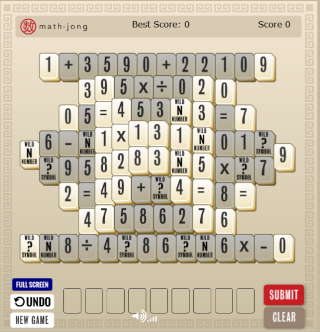Mathjong

Finally there is a game that makes learning math skills fun for kids, and it’s interesting for adults, too! Begin with Mathjong Basic and learn the fundamentals, and then there are four more levels after that, each more challenging than the last.
This is a great skill builder and a fun way to motivate children to practice their mental math skills without being bored as they can easily become with flash cards.
The principle basis for Mathjong is the ancient Chinese tile game Mahjong. If old King Wu had played this version of the game, he may have even liked it better.
Encouraging children to play Mathjong builds their math reasoning skills without making it seem like schoolwork. Very simple equations used early in the learning process will become more involved as players learn that they can complete the game faster by using more numbers in each equation submitted.
When you first begin to play the game, Mathjong may seem easy, but then you fall into the trap of using all your operation symbols, which means you can’t finish the game. With a little practice, you will learn how to get down to a few remaining tiles before you are stumped again.
But don’t give up. You can’t expect to win every game until you are a very accomplished Mathjong player. Mathjong is a single player game, but because the top score is maintained on your computer for a short time, you can challenge others to beat your best score.
You can also work toward bettering your own top score to increase your skills. Keeping a log of your scores on each of the five levels gives you a goal to work toward every time you play the game.
Every Mathjong game is different from the last one because the random number generator places symbols and numbers in different places each time you start a new game. You should never grow tired of playing and you’ll never play the same game twice.
GAMEPLAY
Now that’s something you will have to find out on your own. You may have one equation in which you only score 20 points and another that is worth over 900 points. Once you understand how it all goes together, you can make big scores and clear the boards much more often, too.
After Basic Mathjong, you will graduate to Chinese Fan Mathjong, which will require more concentration. The Diamond Mine deals with nine stacks of tiles and a few single tiles sprinkled over the board. Infinity Mathjong has more tiles stacked so the mystery of what number comes up next is even greater.
By the time you reach Pyramid Mathjong you will be an old hand at the game and well up to the challenge of working with very few tiles at one time.
You should now be ready to begin your quest to reach Pyramid Mathjong. Good luck and have fun!
HOW TO PLAY
Mathjong is a very entertaining game that tests math skills while the player attempts to clear the tiles from the playing board. It requires skills in multiplication, division, addition, and subtraction. Any child who has a basic knowledge of math can play the game. The concept is to do the math mentally, rather than to use paper and pencil.
The gameplay is very similar to the popular game of Mahjong. At the start of the game, a board is shown with light and dark tiles. Only the light tiles can be used to make a math equation in the empty boxes below the playing board. Points are scored based on how difficult the math equation is, and it must be correct or the system will not accept it.
Some tiles are stacked as high as four deep, and the tiles beneath cannot be viewed until the ones above are removed. A dark tile will turn light when the tile directly adjacent to it is selected to go into the equation.
The trick is to keep the operation symbols where they can be chosen as needed. The equal sign is very important to have because no equation can be completed without it. There are also a limited number of all operation symbols.
There are only nine spaces for tiles to be placed below the game board. As numbers and symbols are chosen, they start on the left side in the first box and go across to the right. Here is a sample equation:
8 X 8 / 4 – 8 = 8 (the / denotes division)
This is a correct equation because 8 multiplied by 8 equals 64, which is divided by 4 to equal 16. When 8 is subtracted from 16, the answer is 8.
It is important to note that the equation calculates based on order of operations, meaning multiplication and division precede addition and subtraction.
As all the top tiles are cleared away, wild card tiles are exposed underneath. These are either a wild number or wild symbol to be used as the player sees fit.
The object of the game is to clear the board of all tiles and to score as many points as possible while doing so. Making equations that are a full 9 tiles long on each play provides a better opportunity to complete the game and achieve a higher score.
Another condition to be mindful of is to use as many numbers in equations as possible. Nearing the end of the game it will be impossible to finish without an operator and an equal sign to make an equation.
Two buttons on the left side of the nine-digit equation box are “Undo” and “New Game.” If you start an equation wish to change it, click the undo box and the tiles will go back to where they were moved from. Selecting “New Game” clears your score and starts another game.
On the right side of the equation box is the red “Submit” button you click when you have completed your equation, and the “Clear” button beneath does the same thing as the “Undo” on the left side.
The running score is shown on the top left, and the highest score achieved on the computer is displayed in the top center. Are you ready to play Mathjong? Let’s get started!
Enjoy this game provided by Battleline Studios at embed.com.
